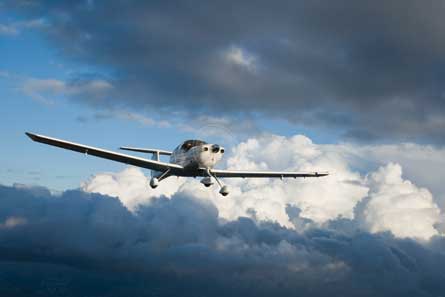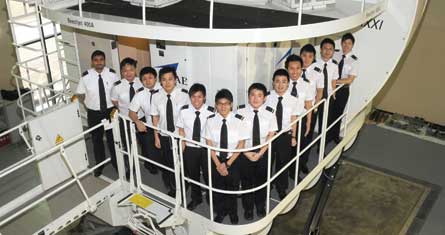Frances Fiorino/Toronto
Traditional airline pilot training is dead? Long live the multi-crew pilot licence method? Not so fast. MPL continues to gain wider acceptance worldwide, but not all sectors of industry are convinced it will produce competent professional pilots.
A visit to CAE's Toronto training facility - where AirAsia cadets had completed the simulator manufacturer's first MPL beta class - provides insight into the rigorous ab initio programme and reality check on several industry misconceptions about the training method.
The MPL is a state-of-the art ab initio programme which, from day one, focuses on training a zero-time student in the core competencies required to safely operate a modern airliner - called airline "mission-specific" training.
 |
|---|
© CAE |
AirAsia multi-crew pilot licence cadets gained flight experience in the Diamond DA40 XLS |
In 2006, the International Civil Aviation Organisation devised the programme in an effort to modernise 30-40-year-old training regimes by using advanced simulator technologies and learning advancements - with an aim of preparing pilots for operating complex transports.
From the start, MPL was widely - and incorrectly - perceived as an ICAO initiative designed to address pilot shortages in Asia. It would use advanced simulator technologies to turn out large numbers of pilots quickly and at lower cost than traditional methods.
Many in industry, including the International Air Transport Association's MPL facilitator Dieter Harms and Flight Safety Foundation chief Bill Voss, emphasise that was never ICAO's intent. "MPL cannot cure the shortage, but it can minimise the threats inherent in the shortage," notes Voss.
CRITICAL CRITERIA
AirAsia MPL leader Capt Dato' Fareh Ishraf Mazputra says the cost and length of training play a role, but are not critical criteria. "The end result is what matters most."
The 15-month-long, four-phase MPL course emphasises the principles of multi-crew operations - crew resource management, as well as threat and error management - from day one. Cadets meet the 240h flight-time requirement mainly in flight simulator training devices.
 |
|---|
© CAE |
AirAsia MPL cadets got their first taste of jet operations in CAE Hawker 400A simulator |
"There has been a lot of emotional reaction to MPL in places like the US," notes Voss. "Yet ab initio training in general has been the norm in the rest of the world for a long time... What's unnerving for some people is that the pilot candidate doesn't get the same 'stack of certificates' with MPL as is required with other methods."
Supporters of MPL argue that the "required hours" or "licence stacking" method builds skills irrelevant to flying a transport aircraft. For example, the novice first learns to fly a single-engined aircraft and logs the required hours and gains the minimum knowledge and skills required to earn the licences and ratings (commercial, instrument, instructor, multi-engine) on the road to an air transport pilot licence.
IATA's Harms, a long-time airline pilot and flight instructor, notes that MPL provides four times more instruction time in multi-crew environment, which has direct relevance to airline operations.
The International Federation of Airline Pilots Associations (IFALPA), which represents more than 100,000 pilots in 100 countries, details several concerns in its official MPL statement. It asks how a novice could gain the skills, leadership and airmanship skills needed to fly a commercial transport after gaining flight experience in a simulator.
IFALPA notes that loss of control or lack of handling abilities were contributing factors in a number of accidents. Therefore, it "strongly believes that maintaining a high number of actual flying hours will ensure that current quality standards are maintained". Cutting them would represent a "significant downgrade" in both quality of training and air safety.
The ICAO "Procedures for Air Navigation Services - Training" (PANS TRG) document provides stringent guidelines for structuring MPL programmes and setting regulatory requirements for cadets, instructors and authorised training organisations.
CONSTANT ASSESSMENT
MPL course material and its participants are constantly assessed and evaluated. Jeffrey Mann, head of training for CAE's commercial business in North America, says training data is collected throughout the course and can be accessed and analysed by all stakeholders.
CAE's MPL project manager Rick Current notes that at any point in time, the regulator, the sponsor airline and the authorised training organisation can access the data bank and analyse the information. "If there is any deficiency, we work to correct it," he says.
 |
|---|
© CAE |
An Airline A320 type rating is the final phase for AirAsia MPL cadets |
AirAsia monitors the programme, the instructors' performance, the authorised training organisation on the execution of the programme as well as the outcome "very closely" to ensure the desired result is achieved, notes Mazputra.
On an Airbus A320 simulator ride to Kuala Lumpur with AirAsia cadets, Eric Dragon in the left seat and Mameet Singh his co-pilot demonstrated their new-found multi-crew skills.
Of the 12 in the group, only Dragon and Singh had flying experience before entering the MPL course. Each had a private pilot licence, and Singh had worked as a dispatcher at a flying school. They offer a unique perspective on MPL. "As a private pilot you are solely responsible for your decisions," notes Singh. "But in MPL you must realise there are other people in the cockpit with shared decision-making responsibility - and you have responsibility for the people sitting in the back."
Dragon says both of them had trouble adjusting to the multi-crew mindset until in the second phase of training when they were able to get rid of their "private pilot thoughts".
However, Dragon was under the impression that their colleagues without any flying experience adjusted faster and better because they had no preconceived notions about flying.
Once a cadet wins the MPL licence, he or she has qualified to fly as a first officer for the sponsor airline. During the course, the AirAsia MPL cadets had gained flight experience in the Diamond DA40 XLS to earn the equivalent of a single-engine private pilot licence and instrument rating, subsequently progressing to a Hawker 400A type rating and, in the last phase, an A320 type rating.
But they would have to fulfil regulatory requirements for other certifications they wish to acquire, such as an instrument rating, or air transport pilot, which requires at least 1,500h.
Dispelling another myth, Transport Canada's director general for civil aviation Martin Eley notes that "MPL holders don't walk out and fly tomorrow".
In late May, the AirAsia cadets were eager to return to Kuala Lumpur, where they completed basic airline training consisting of 12 landings (minimum six) in the A320. They will be required to complete the initial operating experience of 80 segments. "The 2,000-3,000h spent with a captain behind the closed doors of the cockpit are more significant than the 20h you spend in the simulator," notes Voss. In addition, assessment and evaluation of MPL trainee performance will continue.
According to IATA statistics, as of March, about 1,250 students had enrolled in and more than 180 had graduated from MPL courses. Countries that have completed, are conducting or are scheduled to begin MPL training include Australia, Canada, China, Denmark, Germany, Philippines, Singapore, UAE, Sweden, Switzerland, Thailand and the UK.
IATA forecasts that by 2014 the majority of ab initio airline pilots will be trained in the competency-based MPL programme - provided international training and regulatory community can create a globally harmonised and standardised implementation plan. Transport Canada is to issue draft MPL regulations this year, with a final rule following in 2012.
Will the MPL method produce a better trained pilot compared to traditional method? "Theoretically, yes," says Mazputra. "But the result remains to be seen."
For opinion on developments in airline operations and safety visit David Learmount's blog at flightglobal.com/learmount
Source: Flight International























